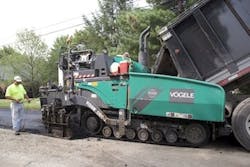Jan. 1, 2011, marked the beginning of the end of allowable particulate matter (PM) and oxides of nitrogen (NOx) emanating from the exhaust pipes of nonroad construction equipment. With that in mind, contractors in the market for a new highway-class asphalt paver have several things to consider. Do you buy a Tier 3 commercial paver that is still legal and maybe save a little money? Or do you purchase a Tier 4 Interim model, or a Tier 4 Final machine, and save yourself the hassle of jumping through hoops later? And, either way, what will you get for your money?
The fourth and final phase of EPA’s emissions standards requirements is ramping up in two final steps. The Tier 4-Interim phase began Jan. 1 for nonroad construction equipment with diesel engines from 175 to 750 horsepower. Nonroad vehicles with engines from 75 to 174 horsepower start transitioning Jan.1, 2012. All nonroad engines must be Tier 4 compliant by 2014, labeled Tier 4-Final.
This final phase provides asphalt-paver manufacturers the opportunity to redesign their machines to meet the new emissions standards and also use the occasion to reconfigure current paver features.
Although the Tier 3 standards were achieved using advanced engine designs to lower emissions, Tier 4 uses control technologies and advanced exhaust gas aftertreatment to meet EPA’s numbers. Aftertreatment components can include:
• Diesel oxidation catalysts (DOC), which remove carbon monoxide, gaseous hydrocarbons and liquid hydrocarbon particles from the exhaust.
• Diesel particulate filters (DPF), which trap particulate matter from the exhaust.
• Passive regenerations systems designed to remove soot from the DPF. Computer-activated active regeneration systems like those found on the Roadtec RP195-E kick in automatically to boost the passive regeneration system.
Aftertreatment components can come installed as single units as in Cat’s C4.4 ACERT engine found in their AP555E asphalt paver, or bundled together to create a clean emissions modular unit.
Asphalt pavers undergoing Tier 4 redesigns are also beefing up current components to help meet the EPA regs.
“We have to fit a lot more components in a similar sized envelope,” says Eric Baker, marketing manager for Roadtec. “In the case of our updated RP195-E Tier 4 paver, the deck of the paver has moved up a bit but this has actually given the operator better visibility.”
The RP195-E engine compartment was sized up and is a bit tighter to accommodate the aftertreatment modules, so Roadtec’s engineers mounted the radiator to swing out with the engine compartment door without sacrificing any of the machine’s serviceability.
“The RP195-E’s operator station is completely redesigned and now features an electric joystick control, replacing the old mechanical levers,” Baker says. “When the operator swings out from the machine, the controls will stay in line with him. Our RP-190 model is also undergoing changes with better operator visibility and a Tier 4 engine.”
Changes to other basic systems help to control emissions and can lead to better performance and fuel efficiency. Terex’s CR400, CR500 and CR600 Series pavers are Tier 4-Interim compliant.
“Customers will notice an increased size in our cooling system,” says Joe Musil, senior engineering fellow for Terex Roadbuilding. “The fan size has increased and retained earlier model’s hydraulic drive feature, which allows the fan to run only as fast as necessary, reducing operating noise levels and fuel consumption.”
Tier 3 pavers still have their charm, and manufacturers such as Vogele are highlighting their Tier 3 paver’s advantages. Vogele says its Vision Series pavers are more efficient using substantially larger fuel tanks. Vogele’s 5200-2 carries 106 gallons of fuel on their 10-foot machines, which, according to general manager Brodie Hutchins, is enough fuel to take a contractor through a 10-hour shift.
Beyond the changes Tier 4 brings, contractors seeking to contain costs and work green by using more recycled asphalt pavement (RAP), recycled asphalt shingles (RAS), and other additives in the asphalt mix are finding manufacturers improving screeds and conveyor systems designed to maximize recycled material’s application. Electric-heated screeds are helping to drive success with the pavers. They deliver more uniform heat across the entire width of the screed and help improve compaction densities behind the paver. This is important because, according to the Texas Department of Transportation, the proper combination of substitute binders, RAP, and RAS can reduce the cost of asphalt pavement material by up to 32 percent per ton.
“The cost of asphalt is an important issue,” says Terex Roadbuilding paver applications specialist Bill Rieken. “More producers are going to different additives such as shingles and to warm mix asphalt to lower the mixing costs of asphalt. Some of these additives may require reblending the material to get a better end result than can be achieved by creating a continuous paving process alone. If contractors are running into these issues, then a paver with an auger delivery system, such as the Terex CR652RX or CR662RM, is the solution.”
Commercial asphalt-paver manufacturers are also using this Tier 3/Tier 4 overlap time to offer new and existing equipment at favorable prices. During this phase-in time, under the Transition Program for Equipment Manufacturers, EPA is allowing construction-equipment manufacturers to continue to build in engines that meet earlier Tier 3 emission requirements for a specified, limited percentage of their overall production during the Tier 4 phase in. Tier 4-Final emissions standards, when PM and NOx drop to near-zero levels, apply after the 2014 model year. (CO emission limits will remain unchanged at the Tier 3 level.)
“We see many contractors purchasing new models that have been in dealer inventories for a year or longer in order to get a reduced purchase price on the paver,” says Mark Oehmke, director of sales for Terex Roadbuilding. Oehmke expects dealers are going to have to work through their inventories before there is an increased demand for new pavers from the factory.
Excess inventory coupled with the extension of the depreciation benefits on capital equipment expenditures signed into effect during 2010’s lame duck session gives contractors even more value for their dollars.





